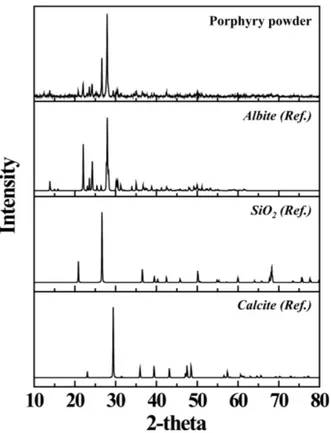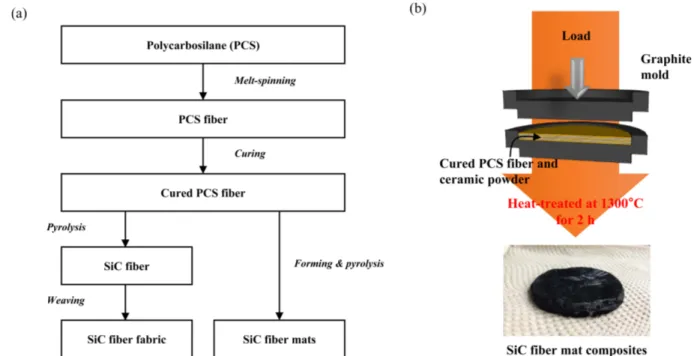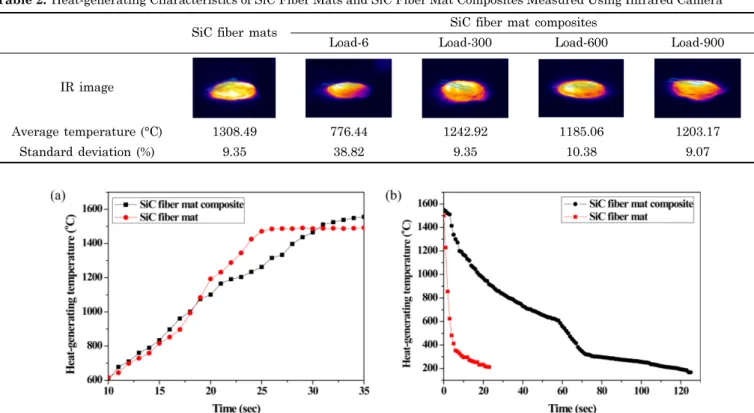Vol. 56, No. 6, pp. 583588, 2019.
583
†Corresponding author : Kwang Youn Cho
E-mail : kycho@kicet.re.kr
Tel : +82-55-792-2710 Fax : +82-55-790-2530 ORCID
https://orcid.org/0000-0002-4367-1408
Heat-Generating Behavior of SiC Fiber Mat Composites Embedded with
Ceramic Powder for Heat Conservation
Young Jun Joo*,** and Kwang Youn Cho *,†
*Fibrous Ceramics & Aerospace Materials Center, Convergence R&D Division, Korea Institute of Ceramic Engineering and Technology, Jinju 52851, Korea
**Division of Nano & Advanced Materials Engineering, Gyeongsang National University, Jinju 52828, Korea (Received September 28, 2019; Revised October 23, 2019; Accepted October 23, 2019)
ABSTRACT
Silicon carbide (SiC) fiber mats generate large amounts of heat through microwave interactions and are used as heating ele-ments in rapid heat treatment furnaces. However, SiC fibers cool immediately when the microwave power is turned off. There-fore, ceramic layers are inserted between the SiC fiber layers to improve the heat conservation performance of SiC fiber mats. In this study, we fabricated SiC fiber mat composites (SMCs) with ceramic layers under various pressures. The SMC fabricated under 0.007 kPa showed the lowest heat-generating temperature and deviation because less necking was observed between the materials. On the other hand, the SMC fabricated under 0.375 kPa showed the highest heat-generating temperature of 1532.33 °C. The SMCs prepared in this study using ceramic powder not only showed heat-generating temperatures comparable to those of conventional SiC fiber mats but also exhibited excellent heat-preserving ability.
Key words : SiC fiber, Ceramic powder, Microwave, Composites, Heat-conservation
1. Introduction
onventional ceramic materials such as oxides, carbides, and nitrides have been extensively used as structural materials owing to their excellent chemical and high-tem-perature heat resistance.1,2) However, ceramics suffer from safety and reliability problems, particularly in the aero-space and automobile fields, because of their low fracture toughness and ductility.3,4) Therefore, composite materials, which show excellent mechanical strength, are used for manufacturing functional composite materials, and hence are promising materials for industrial applications.5-7)
Carbon fibers and SiC fibers are the most common inor-ganic fibers used as reinforcing materials for high-tempera-ture resistant ceramic matrix composites (CMCs).3,4,8) Carbon fibers are relatively inexpensive compared to SiC fibers but decompose in air at temperatures higher than 400°C because of their reaction with oxygen. On the other hand, SiC fibers exhibit high-temperature oxidation resistance even in air because of the presence of a large number of covalent bonds (~ 88%).9)
Polymer-derived silicon carbide (SiC) fibers are promising high-temperature and high-efficiency heating elements and structural materials.10,11) Upon interaction with microwave
energy, amorphous SiC fibers generate heat (above 1400ºC) in about 40–60 s. Moreover, these fibers exhibit long life-times without burning or melting at temperatures as high as 1400°C owing to their high heat resistance. Hence, the heat-generating behavior of polymer-derived SiC fibers has been investigated extensively to realize their heating ele-ment applications for rapid heat treatele-ment.
Amorphous and crystalline SiC fibers are mainly derived from polymers, and polycarbosilane (PCS) is the commonly used SiC precursor.12,13) PCS, which shows an average molecular weight of 3000–4000, is spun in the form of fibers by melt-spinning. These thermoplastic fibers are then con-verted into thermosetting fibers via a curing process. Finally, the cured PCS fibers are pyrolyzed at 1000–1400ºC under an inert atmosphere to convert them into SiC fibers.14) A single-filament of amorphous SiC fibers fabri-cated at 1300ºC usually has a diameter of 10–15 μm and a tensile strength of 1.5–2.0 GPa.15,16)
Porphyry, also known as barley stone, is a type of volcanic rock and contains silica (SiO2) and aluminum oxide (Al2O3) as the main components. Barley stone is known to absorb and decompose harmful substances and can emit far-infra-red (IR) rays that can penetrate 80 times deeper than nor-mal heat.17) In this study, a fine ceramic powder prepared by grinding barley stone was inserted into SiC fiber mats to preserve the generated heat by the interaction of SiC fibers with microwave energy. In addition, as the heat-generating behavior of SiC fibers changes under the application of pres-sure during the heat treatment process,10) the pyrolysis pro-cess was carried out under different pressures to analyze
C
the heat-generating behavior of the SiC fibers in terms of their bonding with the ceramic powder.
2. Experimental Procedure
2.1. Preparation of PCS and cured PCS fibers PCS was used as the ceramic precursor and was pur-chased from TBMTech. Co. Ltd. (Korea). The polymer prop-erties of PCS are summarized in Table 1. PCS, which has a melting point of about 170–180°C, was melt-spun into fibers using a single-hole spinning machine. The curing process is essential for the polymer-to-ceramic transition of PCS fibers while maintaining the fiber shape. In this study, chemical vapor curing was used to cure the PCS fibers with low melt-ing point (< 200°C).18,19) Therefore, PCS fibers with 20–25 µm were prepared in a graphite crucible at a ratio of 1:1 with iodine (CAS No. 7553-56-2, DaeJung Chemical, Korea). The obtained fibers were then heat-treated at 180°C for 2 h.
2.2. Preparation of SiC fiber mats embedded with ceramic powder
Porphyry was used as the ceramic material for heat con-servation and was purchased from SaeroQueen Co. (Korea). Fig. 1 shows the X-ray diffraction pattern (XRD) of porphyry and the reference materials. The ceramic powder prepared by grinding porphyry consisted mainly of the albite (2θ = 27.91°, 22.02°, 27.94°, etc.) and silicon oxide (2θ = 26.63°, 20.85°, 36.52°, etc.) phases.
A graphite mold having a diameter of 60 mm was pre-pared to fabricate a circular mat composite. A five-layered fiber mat composite was fabricated by stacking three layers of the cured PCS fibers and two layers of the ceramic pow-der alternately on the graphite mold. The SiC fibers:ceramic powder ratio of the fiber composite was about 0.5–1.0 weight ratio. The composite composed of the cured PCS fibers and ceramic powder was converted to a SiC fiber mat composite (SMC) by heat-treatment at 1300°C for 2 h in an inert atmo-sphere. After the heat treatment, the ceramic yield of the PCS fibers was 81 wt.% and the weight loss of the ceramic powder was 6.5 wt.%.
During the pyrolysis process at 1300°C, the graphite molds were subjected to different pressures of 0.007, 0.375, 0.749, and 1.124 kPa and the SMCs fabricated at these pressures were labelled as SMC-1, SMC-2, SMC-3, and SMC-4, respectively. A SiC fiber mat without the ceramic powder was also fabricated at 0.375 kPa in order to investigate the effect of the embedded ceramic powder on the thermal char-acteristics of the fiber mats.
2.3. Measurements
The melting point of PCS was measured using a digital melting point instrument (IA9100, Bibby Scientific Co. Ltd., USA). A small amount of PCS was placed in a capillary tube, whose temperature was raised at 10°C/min until the softening point was reached. After reaching the softening point, the temperature was raised at 1°C/min to measure the melting point. Gel permeation chromatography (GPC) analysis was carried out on a system equipped with a Waters 515 HPLC pump, a Waters 2414 refractive index detector, and a series of three Shodex HPLC columns. The GPC instru-ment was calibrated using polystyrene standards and tolu-ene as the solvent at the flow rate of 1 mL/min. The XRD analysis (DMAX 2500, Rigaku, Japan) of the polymer-derived SiC fiber fabricated at 1300°C for 2 h and the ceramic pow-der was carried out using Cu K radiation over the 2θ range of 10–80°. The heat-generating behaviors of the SiC fiber mat and SMCs (containing the ceramic powder) were inves-tigated using a microwave generation system (DAEHO I&T Co. Ltd., Korea) equipped with one magnetron (2.45 GHz). The maximum heat-generating temperature and tempera-ture distribution of the samples under microwave were determined using an IR camera (HotFind DXS, SDS, Europe). The joining interface between the fiber and ceramic powder layers of the SMCs was observed using scanning electron microscopy (SEM) (EM-30AX, COXEM, Korea).
Table 1. The Characteristics of PCS Measured by Gel Permeation Chromatograph and Melting Point Analyzer
Mw (Daltons) Mn (Daltons) Dp Ts (°C) Tm (°C)
3614 1378 2.62 136 170–180
Mw: weight average molecular weight, Mn: number average
molecular weight, Dp: polydispersity, Ts: softening point, and
Tm: melting point
Fig. 1. X-ray diffraction pattern of purchased porphyry and reference materials.
3. Results and Discussion
SiC fiber fabrics are generally woven using continuous fibers. The weaving of these fabrics is a complex and expen-sive process. However, in this study, the mat composites were fabricated simply by cutting and stacking the cured PCS fibers and ceramic powder before the formation of SiC fibers, as shown in Fig. 2(a). Hence, the SMCs containing the ceramic powder could be easily fabricated by simply applying pressure, as shown in Fig. 2(b).
Figure 3 shows the XRD pattern of the SiC fiber fabri-cated at 1300°C for 2 h in an inert atmosphere and the pur-chased ceramic powder. The amorphous SiC fiber obtained
at 1300°C showed broad β-SiC phase peaks at 2θ = 35.74°, 60.26°, and 72.03°. Uniform and round shape via inserted SEM image. As the ceramic powder was melted at a rela-tively low temperature by the alkali system, it showed an amorphous phase and weak SiO2 (at 2θ = 26.71°; maganite) and Fe (at 2θ = 44.68° and 65.03°) peaks.
It has been reported that the heat-generating behavior of SiC fiber sheets fabricated via electrospinning depends on the sheet thickness and the number of SiC fiber layers.10,11) Therefore, the thickness of the SMCs prepared under differ-ent pressures was controlled (during the heat treatmdiffer-ent process under the inert atmosphere) in this study.
The maximum heat-generating temperatures of the SMCs under the microwave exposure were measured using an IR camera, as shown in Fig. 4. The microwave power was adjusted by increasing the current from 0 to 6.5 A at 220 V. Fig. 2. (a) Flow diagram and (b) schematic drawing of the methods for making three-dimensional structures using SiC fibers.
Fig. 3. XRD patterns of polymer-derived SiC fiber and com-mercial ceramic powder after the heat-treated at 1300°C for 2 h in an inert atmosphere. Inset SEM image show the shape of the SiC fibers.
Fig. 4. The maximum heat-generating temperature and thickness of SiC fiber mats and SCMs fabricated at 1300°C for 2 h.
The maximum heat-generating temperature of the SiC fiber mat fabricated without the ceramic powder was 1479.68°C. On the other hand, the SMC-1, SMC-2, SMC-3, and SMC-4 samples showed the maximum heat-generating tempera-tures of 1206.80, 1532.33, 1501.13, and 1441.49°C, respec-tively. With an increase in the pressure applied during the heat treatment, the thickness of the SMC samples decreased from about 2.7 to 1.8 mm. The heat-generating temperature of the SMCs first increased with an increase in the applied pressure up to 0.375 kPa and then decreased. This is because the ceramic powder penetrated the SiC fibers under excessive pressure, which reduced the necking of the SiC fibers.10)
The heat-generating characteristics for the fiber mat and
SMCs are summarized in Table 2. The SiC fiber mat with-out the ceramic powder consisted of a single material only. This mat showed the highest average heat-generating tem-perature among all the samples. SMC-1 on the other hand, showed heterogeneous heat-generating temperature because of the poor bonding between the inserted ceramic powder and the SiC fibers. Therefore, with an increase in the pres-sure applied during the heat treatment, the average tem-perature of the SMCs increased.
All the samples were observed in real-time using an IR camera under microwave exposure to investigate the effect of the ceramic powder on the heating and cooling rates of the samples. As can be observed from Fig. 5(a), the SiC fiber mat took about 25 s to reach the maximum heat-generating Table 2. Heat-generating Characteristics of SiC Fiber Mats and SiC Fiber Mat Composites Measured Using Infrared Camera
SiC fiber mats SiC fiber mat composites
Load-6 Load-300 Load-600 Load-900
IR image
Average temperature (°C) 1308.49 776.44 1242.92 1185.06 1203.17
Standard deviation (%) 9.35 38.82 9.35 10.38 9.07
Fig. 5. (a) Heating rate depending on the interaction with microwave and (b) cooling rate after switching off the microwave power of SiC fiber mat and SiC fiber mat composite.
temperature. On the other hand, the SMCs took approxi-mately 15 s longer than the SiC fiber mat because they con-sumed energy to heat the inserted ceramic powder. In case of the cooling rate, the SMCs radiated heat at temperatures higher than 200°C for 120 s because of the presence of the ceramic powder, which showed heat conservation capabil-ity. Fig. 5(b) shows the difference in the cooling rates of the SiC fiber mat and SMCs. The SiC fiber mat cooled rapidly because of its high thermal conductivity and large specific surface area, while the SMCs showed significantly improved heat conservation because of the presence of porphyry pow-der, which receives heat from the surroundings and emits far-IR rays.
Figure 6 shows the SEM images of the cross-section and surface of the SMCs containing the ceramic powder. When the SMCs were cut vertically for the cross-sectional observa-tion, a gap was formed between the layers because the mechanical bond was broken. This indicates that the pow-der did not penetrate deep into the fiber layer. As can be observed from Fig. 6(b), the ceramic powder melted during the heat treatment process and formed a layer between the SiC fiber layers. In addition, the ceramic layer was bonded to the shallow surface of the fiber layer.
4. Conclusions
A ceramic powder composed mainly of the albite and SiO2 phases was embedded between polymer-derived SiC fibers to prepare SiC fiber mats generating heat under microwave irradiation. SMCs were easily prepared by alternately stacking the cured PCS fibers and ceramic powder and then heat-treating the resulting assembly in an inert atmosphere under various pressures. The heat-generating properties of the SMCs with the ceramic powder depended on the pres-sure applied during the heat treatment. The SMC prepared under 0.375 kPa showed a temperature deviation of 9% and the highest heat-generating temperature of 1532°C in about 30 s. In addition, the SMCs radiated heat at temperatures higher than 200°C over a long period of time as compared to the SiC fiber mats. Therefore, the SMCs prepared in this study by mechanical bonding with the ceramic powder through high-temperature heat treatment are promising high-efficiency and ultra-high temperature heating elements.
Acknowledgments
This work was financially supported by the Korea Insti-tute of Ceramic Engineering and Technology (KICET) and Ministry of Trade, Industry and Energy (MOTIE:P0010094) of the South Korea government.
REFERENCES
1. V. V. Vikulin, I. Y. Kelina, A. S. Shatalin, and L. N. Rusa-nova, “Advanced Ceramic Structural Materials,” Refract. Ind. Ceram., 45 [6] 383–86 (2004).
2. U. Täffner, V. Carle, U. Schäfer, and M. J. Hoffmann, “Preparation and Microstructural Analysis of High-Per-formance Ceramics”; pp. 1057–66 in Metallography and Microstructures, Vol. 9, Metallography and Microstruc-tures of Ceramics, Composite-Metal Forms, and Special Purpose Alloys. Ed. by G. V. Voort, ASM International, USA, 2004.
3. R. Naslain, “Design, Preparation and Properties of Non-Oxide CMCs for Application in Engines and Nuclear Reac-tors: An Overview,” Compos. Sci. Technol., 64 [2] 155–70 (2004).
4. B. Budiansky and J. W. Hutchinson, “Matrix Fracture in Fiber-Reinforced Ceramics,” J. Mech. Phys. Solids, 34 [2] 167–89 (1986).
5. E. Bernardo, L. Fiocco, G. Parcianello, E. Storti, and P. Colombo, “Advanced Ceramics from Preceramic Polymers Modified at the Nano-Scale: A Review,” Materials, 7 [3] 1927–56 (2014).
6. A. Muc and M. Barski, “Design of Particulate-Reinforced Composite Materials,” Materials, 11 [2] 234 (2018). 7. F. Lenz and W. Krenkel, “Carbon Fiber Reinforced
Ceramics based on Reactive Melt Infiltration Processes,” J. Korean Ceram. Soc., 49 [4] 287–94 (2012).
8. S. Schmidt, S. Beyer, H. Knabe, H. Immich, R. Meistring, and A. Geessler, “Advanced Ceramic Matrix Composite Materials for Current and Future Propulsion Technology Applications,” Acta Astronaut., 55 [3-9] 409–20 (2004). 9. V. A. Izhevskyi, L. A. Genova, J. C. Bressiani, and A. H.
Bressiani, “Review Article: Silicon Carbide. Structure, Properties and Processing,” Cerâmica, 46 [297] 4–13 (2000). 10. K. E. Khishigbayar, J. M. Seo, and K. Y. Cho, “Heating
Behavior of Silicon Carbide Fiber Mat under Microwave,” J. Korean Ceram. Soc., 53 [6] 707–11 (2016).
11. K. E. Khishigbayar, Y. J. Joo, and K. Y. Cho, “Microwave-Assisted Heating of Electrospun SiC Fiber Mats,” J. Korean Ceram. Soc., 54 [6] 499–505 (2017).
12. S. Yajima, Y. Hasegawa, J. Hayashi, and M. Iimura, “Synthesis of Continuous Silicon Carbide Fibre with High Tensile Strength and High Young’s Modulus Par 1 Syn-thesis of Polycarbosilane as Precursor,” J. Mater. Sci., 13 [12] 2569–76 (1978).
13. R. Usukawa, H. Oda, and T. Ishikawa, “Conversion Pro-cess of Amorphous Si-Al-C-O Fiber into Nearly Stoichio-metric SiC Polycrystalline Fiber,” J. Korean Ceram. Soc., 53 [6] 610-4 (2016).
14. Y. Hasegawa and K. Okamura, “Synthesis of Continuous Silicon Carbide Fibre Part 3 Pyrolysis Process of Polycar-bosilane and Structure of the Products,” J. Mater. Sci., 18 [12] 3633–48 (1983).
15. A. R. Bunsell and A. Piant, “A Review of the Development of Three Generations of Small Diameter Silicon Carbide Fibres,” J. Mater. Sci., 41 [3] 823–39 (2006).
16. D. G. Shin, D. H. Riu, Y. H. Kim, H. R. Kim, H. S. Park, and H. E. Kim, “Characterization of SiC Fiber Derived from Polycarbosilanes with Controlled Molecular Weight,” J. Korean Ceram. Soc., 42 [8] 593–98 (2005).
17. Y. S. Han, H. J. Kim, Y. S. Shin, J. K. Park, and J. C. Ko, “Silver Coating on the Porous Pellets from Porphyry rock and Application to an Antibacterial Media,” J. Korean
Ceram. Soc., 46 [1] 16–26 (2009).
18. J. S. Hong, K. Y. Cho, D. G. Shin, J. I. Kim, S. T. Oh, and D. H. Riu, “Low-Temperature Chemical Vapour Curing Using Iodine for Fabrication of Continuous Silicon Car-bide Fibres from Low-Molecular-Weight Polycarbosilane,”
J. Mater. Chem. A, 2 [8] 2781–93 (2014).
19. J. S. Hong, K. Y. Cho, D. G. Shin, J. I. Kim, and D. H. Riu, “Iodine Diffusion during Iodine-Vapor Curing and its Effects on the Morphology of Polycarbosilane/Silicon Car-bide Fibers,” J. Appl. Polym. Sci., 132 [47] 42687 (2015).


